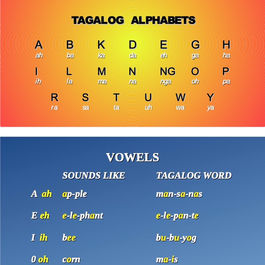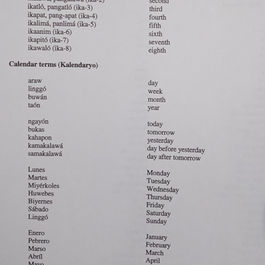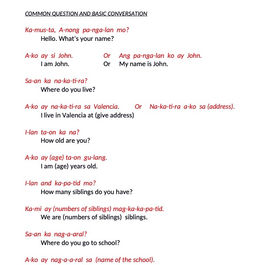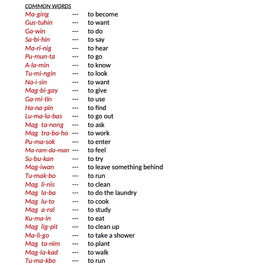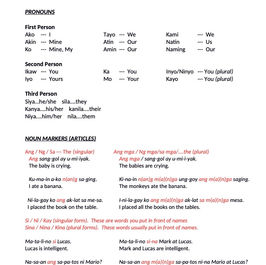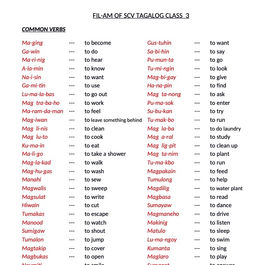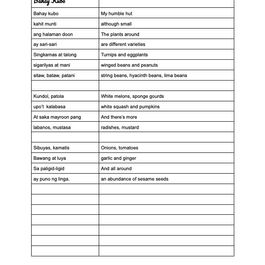

" One who doesn’t love his native tongue, Is worse than putrid fish and beast; and like a truly precious thing. It therefore deserves to be cherished.
The Tagalog language’s akin to Latin, To English, Spanish, angelical tongue;For God who knows how to look after us. This language He bestowed us upon."
- Dr. Jose Rizal, Philippines National Hero
The early settlers of the Philippines dates back as early as 250,000 years ago. Evidence of people from the Malayan Archipelago were the first to arrive the Philippine Islands. Coming during the Ice Age, they are believed to have crossed on a land bridge that no longer exists. These early settlers were followed roughly15,000 years ago by a Mongoloid people from Southeast Asia who also crossed on the land bridge. The conglomeration of these people may have possibly been the root of the approximately 100 different languages spoken today in the Philippines. The archeological evidence of these people is still to date, being confirmed.
Then from 7000 BC to 2000 BC larger groups of people began migrating from China and Vietnam. The Third century BC was when the largest migration took place when people from the Malay Peninsula and the Indonesian Archipelago started heading towards the beautiful tropical islands. The Austronesian Language Family was the language brought on by these migrants which is became the basis for the various Philippine languages, and making the Tagalog the common language and thus becoming the National Language of the Philippines.
The Sanskrit, a language of India, was then introduced through direct trade and indirect cultural influence through travels from India through the Malaysian Peninsula and on into the Philippines. in the beginning in the Fifth Century AD. Trade in Southeast Asia erupted, and the interaction between the countries in this region of the world was boosted immensely. Traders sailed all over the Indian Ocean and the South China Sea to barter their goods. As a side-effect of this interaction, the languages interacted as well. Hindu brought many new customs into these countries. New words had to be borrowed and created to allow for the new customs and traditions.
The Spanish was the next group of people to have a major affect on the Tagalog language. Beginning in the second half of the 16th Century, catholic friars from Spain began pouring into the Philippines. The Augustinians were the first to come, arriving in 1565. They established the first permanent European residence in the Philippines. They were followed by the Franciscans in 1577, the Jesuits in 1583, and the Dominicans in 1595 (Wolf).
With them, the catholic friars brought the Spanish language. All of the friars learned to speak Tagalog, but a great number of Spanish words naturally drifted into the Tagalog language including mainly religious, governmental, social, legal, and abstract terms (Aspillera, viii). One example can be seen in the Tagalog greeting, kumusta ka, which bears great resemblance to the Spanish cómo está.
When the Catholics settled in the islands, they began translating Christian works into Tagalog. The first book printed in the Philippines, the Doctrina Christiana, was written in the Spanish language and the Tagalog language, using the traditional Tagalog characters as well as the Roman alphabet (Wolf). Because of the Spanish impact, not only the language changed, but the writing system as well. After the Spaniards came, the Tagalog language was written using the Roman alphabet as opposed to the traditional Tagalog alphabet.
On December 10, 1898, the Philippine islands were ceded to the United States in the Treaty of Paris and that's when the Spanish lost control over the Philippines and English was introduced into Tagalog. The US continued to control the Philippines until, in 1946, the Republic of the Philippines was established. Even though this ended US rule in the Philippines, interactions continued to take place, and English words continue to trickle into the Tagalog lexicon.
In just the few centuries from when the trade in Southeast Asia began flourishing, and Sanskrit started to seep into the Tagalog lexicon until today, the language has undergone innumerable changes. The Sanskrit influence expanded the vocabulary immensely. The Spanish impact also added to the vocabulary and, in addition, changed the orthography. The English effect can additionally be seen in the lexicon. Indeed, all school children in the Philippines today learn to speak English, and the majority of middle-aged people speak some English as well. Very educated people may even speak English with each other at times because it is a more prestigious language (Interview). Tagalog has not yet reached its final destination, it is still changing daily, but as we look back on its roots, we can observe the patterns of change, and then look toward the future, to its final destination.
THE EVOLUTION OF THE TAGALOG LANGUAGE
Excerpt from Jessica Klakring
